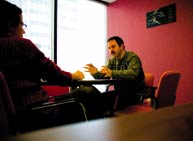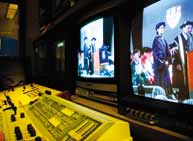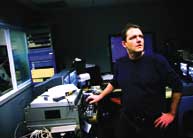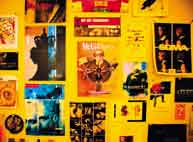Mission: Instructional
Bad news for the paranoid. There's a three-letter agency operating at McGill, and they've thoroughly infiltrated the university. They're on the walls, on the internet, in the libraries and in the classroom. Armed with a sophisticated array of video and audio recording equipment, software, high-powered computers - even a sinister-looking black satellite dish atop the Burnside Building - their capabilities are only getting greater.

Garry Graham (right)
Claudio Calligaris
The FBI? CIA? Try ICC - the Instructional Communications Centre. From their secret headquarters on the 16th floor of 688 Sherbrooke, this little-known but ubiquitous organization handles everything from designing multimedia materials to loaning audiovisual equipment. ICC's mission is to support the use of technology in teaching and to provide cost-effective professional graphic design, photo, video and courseware production services. Audiovisual Arrangements offices in the Redpath Library Building and at Macdonald Campus loan out and repair audiovisual equipment and laptop computers. They also maintain all of the equipment in classrooms and lecture theatres.
Adam Finkelstein, manager of courseware production, doesn't look like an undercover agent (but then again, he wouldn't, would he?). The courseware production group works with instructors to design effective learning materials that can enhance the classroom experience for students and professors.
Examples of this are on the ICC website (www.mcgill.ca/icc). One recent project with the Faculty of Dentistry led to Interceptive Orthodontics: Diagnosis, an online teaching module that aims to provide theoretical and practical skills for students in orthodontics.
This program allows students to make virtual diagnoses using actual pateient materials - photos, X-Rays and tooth casts, which they can examine with virtual dental tools. A section on cephalometric analysis shows an X-Ray of a head in profile. Hotlinks in the text beside the image bring up markers on the picture to explain to learners the analytical context.
Another section allows students to practice measuring teeth using a virtual Boley guage, they would as professionals.
That isn't what has Finkelstein excited these days. ICC has recently licensed a software program called Camtasia, which will allow instructors to audio record their lectures, along with anything on their computer screens, for later playback.
Technophobes, needn't despair. Although Camtasia is multi-functional, it really is simple to use. When Finkelstein demonstrated the software for this reporter, he simply turned on the program, set the recording volume and typed a short message into Microsoft Word. When he played it back on Camtasia, you could see the message being typed in again - including typo corrections - along with the sound of his narration, including the digitally rendered percussive sounds of the keyboard.
Where programs like PowerPoint capture output - one-at-a-time bullet points of information - Camtasia will allow instructors to show, step by step, each stage of an equation as it is calculated, or a graph as it is drawn, along with a professor's words of wisdom as accompaniment.
And there's more.
"You can add interactivity to it afterwards, so you can add a highlight here, an extra video track here. You can convert it into any kind of output, like Flash, and you can share it by putting it on CD, on the web or WebCT," said Finkelstein.
The new software, which is free for all McGill instructors to use, builds on existing services like the Department of Chemistry COOL technology, which combines lecture recordings with PowerPoint playback. Camtasia won't be replacing those services, just adding to them.
"There're always people who say 'Well if I do this, why would my students come to class?'" he said.
Finkelstein - who is currently completing his PhD in instructional psychology - said that experience has shown that use of software like Camtasia doesn't lead to increased absenteeism. Rather, students use archived lectures for review, a particularly handy service for students whose first language is not English.
"It also allows you to do things differently in a classroom. You can say, why don't you watch the presentation online before you come to class, and then in class let's do some discussions or presentations," said Finkelstein.
Jean-Guy Tremblay, the associate director of the multimedia and audiovisual section of the department, explained that his section will be responsible for two new initiatives.
The Burnside Building is home to a huge streaming server, an electronic beast dedicated to digital video and audio services. It has already been used to broadcast parts of the Rethink Conference live on the internet, but it can do more.
Professors who use video materials for their students can take advantage of this server. Instead of having a limited number of tapes available at the library, or taking up class time showing movies, students can log on to the server and watch videos at their own leisure (although Tremblay cautions the system is not terribly useful on dial-up connections). Already ICC has recorded a 52-minute videotape on Nile crocodiles on to the server for a biology exam.
"If the physics department wants episodes of "NOVA" on there, we can do that," said Tremblay.
The only thing a professor needs to do - and this is important, cautioned Tremblay - is to get permission from any show's producers before giving it to ICC to put on the server.
With the satellite, and permission to rebroadcast, it will be possible to receive images from events around the world. Say the General Secretary of the UN is addressing a conference in Fresno, California: if that were being transmitted to a satellite, it would be possible for McGill students to view it on their computers.
The server can also be used to broadcast events from campus.

Claudio Calligaris
"This is accessible from everywhere. It's a window to the world," said Tremblay.
Another such window his team is offering is MediaSite Live, a service that combines video link-ups with presentation software.
This program can be useful for room overflows. With an ICC camera, video and computer presentations can be broadcast simultaneously, and archived as well. The software allows for a certain amount of feedback, like live polling. The video stream and slide presentations can be linked, so on playback a user can click on a slide they want explained and the video will automatically start from that point of the presentation.
"It's like a book: you can go from chapter to chapter," said Tremblay.

Stewart McCombie in a video-editing suite
Claudio Calligaris
The advent of computer-generated everything hasn't replaced all of the multimedia section's traditional roles. Stewart McCombie, assistant producer/director in the television and production section, took this reporter on a tour of the TV studio on the second floor of 688 Sherbrooke.
It looks just as you would expect - one section curtained off with chairs and microphones for an ongoing music department project, a back room with cameras and teleprompters. Off the one side in the main room is a hospital bed, left over from a research project.
"I've filmed skits in here, and things like Principal's messages to events that she can't attend in person," said McCombie.
The studio has also been used for a 12-part television series on farming in Quebec run by professors at Macdonald Campus that was broadcast on cable.
Garry Graham, the art director and manager of ICC's graphic design department, is responsible for much of McGill's visual identity, be it on posters, brochures, websites, event invitations, PowerPoint displays or websites: often it comes from the fertile minds of the six people in his office.
These designers have to balance McGill's sense of history with cutting-edge technology, as many of the materials they send out have to appeal to a wide range of interests. Recruiting documents, for instance, have to be true to the university, yet appeal to both prospective students, and their parents.
"We try to mix in McGill's tradition of excellence in teaching and academics, but we also try to keep it fresh - we don't want to appear stodgy," said Graham.

From the graphic design department
Claudio Calligaris
"Even though we're graphic designers, we have to be aware of the history and theory of visual arts. Some of the best work seems simple, but it takes a lot of work to get to that point."
One such project was the recent redesign of the McGill diploma. Working with a specialty printer, the designers added a varnish that should extend the life of the document, as well as added security features that will prevent it from being copied.
As with many of ICC's other services, the graphic design department services are heavily discounted for teaching purposes. Graham himself worked with The Gazette and several private design firms around Montreal before coming to McGill.
"I wanted to do something more meaningful, and education seemed a good environment," he said.
ICC will be hosting an information session on Camtasia, MediaSite Live and the streaming server on May 25 from 1 pm to 2 pm in the McConnell Engineering Building, Room 204.
